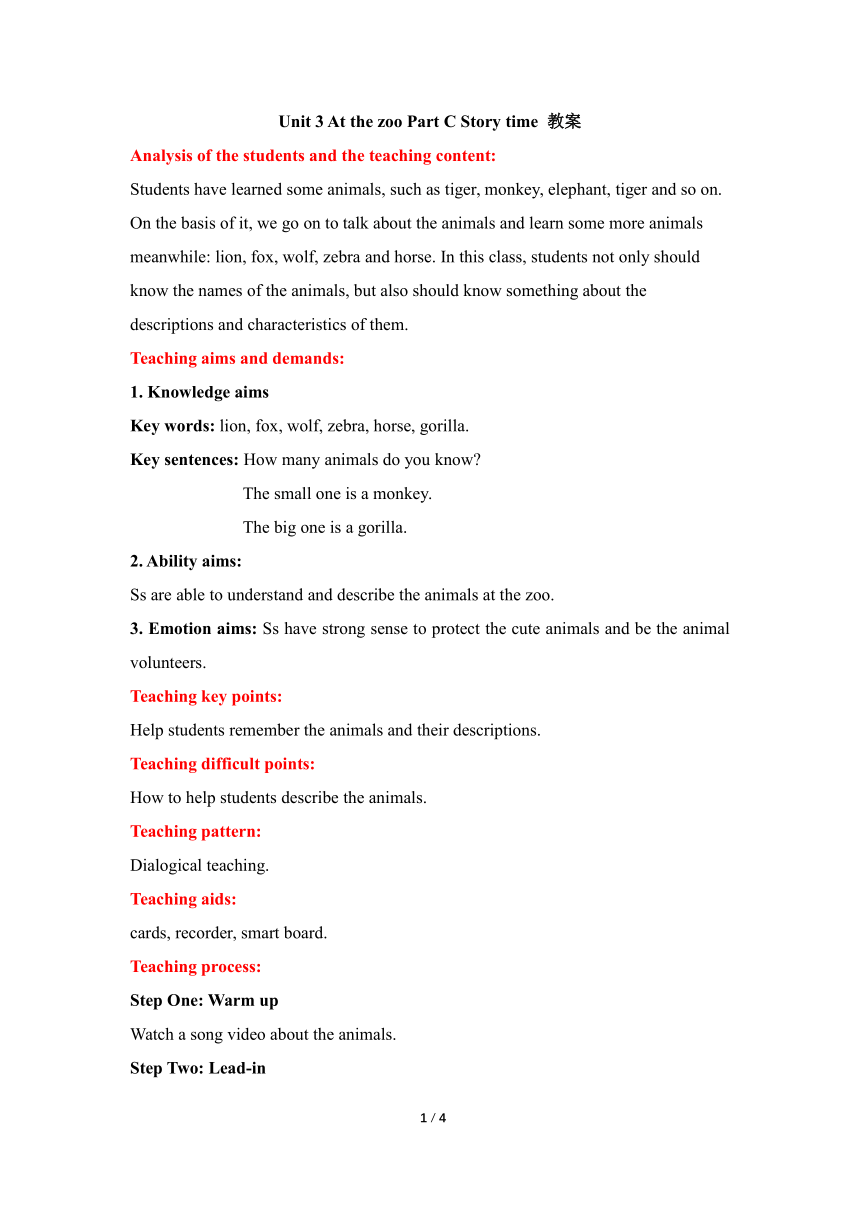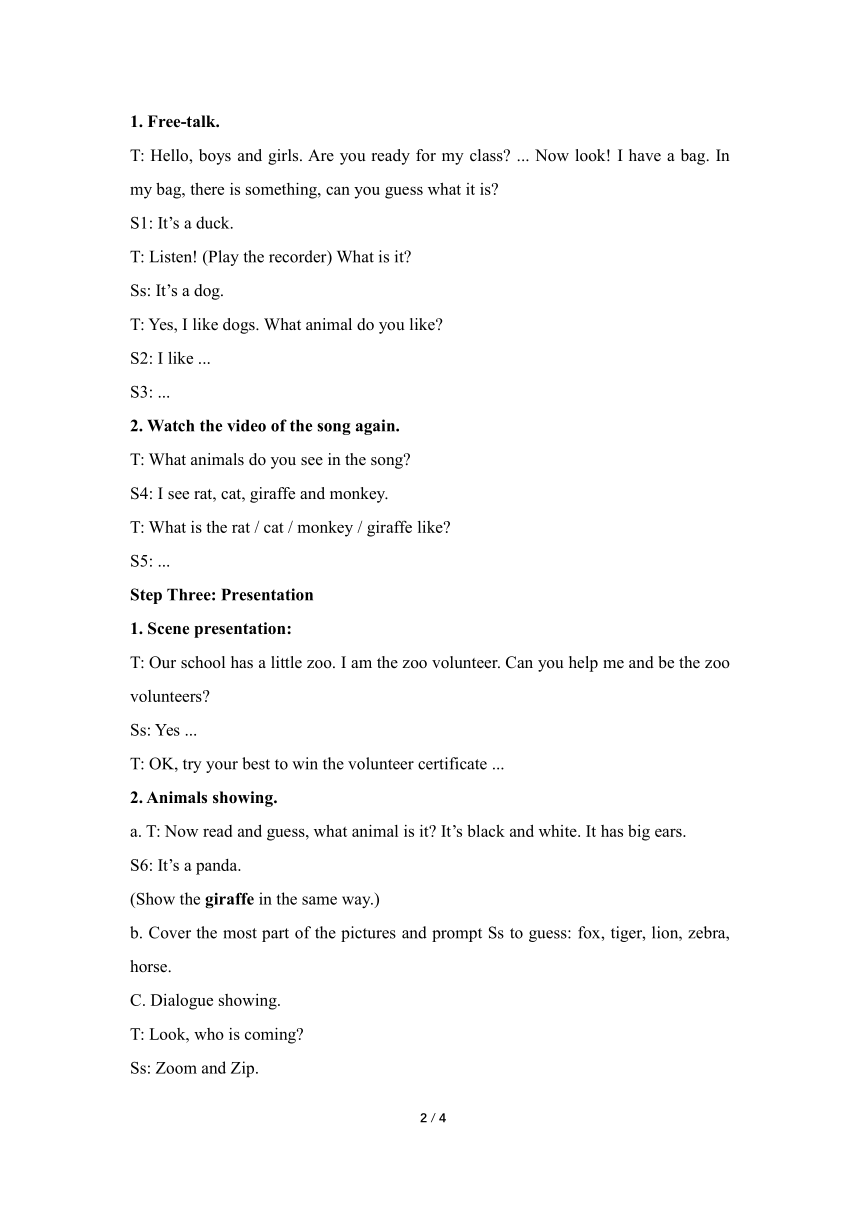Unit 3 At the zoo Part C Story time 全英教案
文档属性
| 名称 | Unit 3 At the zoo Part C Story time 全英教案 |  | |
| 格式 | zip | ||
| 文件大小 | 10.2KB | ||
| 资源类型 | 教案 | ||
| 版本资源 | 人教版(PEP) | ||
| 科目 | 英语 | ||
| 更新时间 | 2019-04-13 15:18:12 | ||
图片预览


文档简介
Unit 3 At the zoo Part C Story time 教案
Analysis of the students and the teaching content:
Students have learned some animals, such as tiger, monkey, elephant, tiger and so on. On the basis of it, we go on to talk about the animals and learn some more animals meanwhile: lion, fox, wolf, zebra and horse. In this class, students not only should know the names of the animals, but also should know something about the descriptions and characteristics of them.
Teaching aims and demands:
1. Knowledge aims
Key words: lion, fox, wolf, zebra, horse, gorilla.
Key sentences: How many animals do you know?
The small one is a monkey.
The big one is a gorilla.
2. Ability aims:
Ss are able to understand and describe the animals at the zoo.
3. Emotion aims: Ss have strong sense to protect the cute animals and be the animal volunteers.
Teaching key points:
Help students remember the animals and their descriptions.
Teaching difficult points:
How to help students describe the animals.
Teaching pattern:
Dialogical teaching.
Teaching aids:
cards, recorder, smart board.
Teaching process:
Step One: Warm up
Watch a song video about the animals.
Step Two: Lead-in
1. Free-talk.
T: Hello, boys and girls. Are you ready for my class? ... Now look! I have a bag. In my bag, there is something, can you guess what it is?
S1: It’s a duck.
T: Listen! (Play the recorder) What is it?
Ss: It’s a dog.
T: Yes, I like dogs. What animal do you like?
S2: I like ...
S3: ...
2. Watch the video of the song again.
T: What animals do you see in the song?
S4: I see rat, cat, giraffe and monkey.
T: What is the rat / cat / monkey / giraffe like?
S5: ...
Step Three: Presentation
1. Scene presentation:
T: Our school has a little zoo. I am the zoo volunteer. Can you help me and be the zoo volunteers?
Ss: Yes ...
T: OK, try your best to win the volunteer certificate ...
2. Animals showing.
a. T: Now read and guess, what animal is it? It’s black and white. It has big ears.
S6: It’s a panda.
(Show the giraffe in the same way.)
b. Cover the most part of the pictures and prompt Ss to guess: fox, tiger, lion, zebra, horse.
C. Dialogue showing.
T: Look, who is coming?
Ss: Zoom and Zip.
T: Zoom wants to be zoo volunteer, too. Now let’s see if he can be the volunteer. Listen to their dialogues. (Students listen and try to judge.)
S7: Zoom can’t be the zoo volunteer.
T: Why?
(Help Ss understand the sentences meanwhile: The small one is a monkey. The big one is a gorilla. And they can compare and say the sentences like this: The long one is a pencil. The short one is a pen.)
Step Four: Practice
1. Read the dialogues after the recorder.
2. Pair-work: role play the dialogues.
3. Cover some key words and make Ss role play the dialogues.
Step Five: Extension
1. Feed the animals.
T: You did a good job. Now the animals are hungry. We are zoo volunteers. Let’s feed the animals. I love the panda. The bamboo is for the panda. What about these food? Can you help me feed them?
Ss feed the animals and say as follows: This is for the horse...
2. Help Ss find their descriptions. Match the pictures with the sentences.
Step Six: Consolidation
1. Design a logo for the animals in their group.
a. Ss look at my logo for the panda and understand how to design the logo.
b. Several minutes for them to design. They can discuss in their groups.
c. Each group choose a reporter to report his/her logo.
2. Show the advertising video I made for the animals in our zoo. Ss look and sense that we should love and protect the animals. At last, they say loudly: Animals, animals, I love you!
Step Seven: Homework
Make a poster to show the animals in our little zoo.
Board design
At the zoo
The small one is a monkey.
The big one is a gorilla.
Reflections after class:
In this class. Ss are eager to be the zoo volunteers. They can grasp the descriptions and characteristics of the animals. They are willing to protect the animals. Maybe because I didn’t spend much time helping them reading the dialogues, some students couldn’t read skillfully.
Analysis of the students and the teaching content:
Students have learned some animals, such as tiger, monkey, elephant, tiger and so on. On the basis of it, we go on to talk about the animals and learn some more animals meanwhile: lion, fox, wolf, zebra and horse. In this class, students not only should know the names of the animals, but also should know something about the descriptions and characteristics of them.
Teaching aims and demands:
1. Knowledge aims
Key words: lion, fox, wolf, zebra, horse, gorilla.
Key sentences: How many animals do you know?
The small one is a monkey.
The big one is a gorilla.
2. Ability aims:
Ss are able to understand and describe the animals at the zoo.
3. Emotion aims: Ss have strong sense to protect the cute animals and be the animal volunteers.
Teaching key points:
Help students remember the animals and their descriptions.
Teaching difficult points:
How to help students describe the animals.
Teaching pattern:
Dialogical teaching.
Teaching aids:
cards, recorder, smart board.
Teaching process:
Step One: Warm up
Watch a song video about the animals.
Step Two: Lead-in
1. Free-talk.
T: Hello, boys and girls. Are you ready for my class? ... Now look! I have a bag. In my bag, there is something, can you guess what it is?
S1: It’s a duck.
T: Listen! (Play the recorder) What is it?
Ss: It’s a dog.
T: Yes, I like dogs. What animal do you like?
S2: I like ...
S3: ...
2. Watch the video of the song again.
T: What animals do you see in the song?
S4: I see rat, cat, giraffe and monkey.
T: What is the rat / cat / monkey / giraffe like?
S5: ...
Step Three: Presentation
1. Scene presentation:
T: Our school has a little zoo. I am the zoo volunteer. Can you help me and be the zoo volunteers?
Ss: Yes ...
T: OK, try your best to win the volunteer certificate ...
2. Animals showing.
a. T: Now read and guess, what animal is it? It’s black and white. It has big ears.
S6: It’s a panda.
(Show the giraffe in the same way.)
b. Cover the most part of the pictures and prompt Ss to guess: fox, tiger, lion, zebra, horse.
C. Dialogue showing.
T: Look, who is coming?
Ss: Zoom and Zip.
T: Zoom wants to be zoo volunteer, too. Now let’s see if he can be the volunteer. Listen to their dialogues. (Students listen and try to judge.)
S7: Zoom can’t be the zoo volunteer.
T: Why?
(Help Ss understand the sentences meanwhile: The small one is a monkey. The big one is a gorilla. And they can compare and say the sentences like this: The long one is a pencil. The short one is a pen.)
Step Four: Practice
1. Read the dialogues after the recorder.
2. Pair-work: role play the dialogues.
3. Cover some key words and make Ss role play the dialogues.
Step Five: Extension
1. Feed the animals.
T: You did a good job. Now the animals are hungry. We are zoo volunteers. Let’s feed the animals. I love the panda. The bamboo is for the panda. What about these food? Can you help me feed them?
Ss feed the animals and say as follows: This is for the horse...
2. Help Ss find their descriptions. Match the pictures with the sentences.
Step Six: Consolidation
1. Design a logo for the animals in their group.
a. Ss look at my logo for the panda and understand how to design the logo.
b. Several minutes for them to design. They can discuss in their groups.
c. Each group choose a reporter to report his/her logo.
2. Show the advertising video I made for the animals in our zoo. Ss look and sense that we should love and protect the animals. At last, they say loudly: Animals, animals, I love you!
Step Seven: Homework
Make a poster to show the animals in our little zoo.
Board design
At the zoo
The small one is a monkey.
The big one is a gorilla.
Reflections after class:
In this class. Ss are eager to be the zoo volunteers. They can grasp the descriptions and characteristics of the animals. They are willing to protect the animals. Maybe because I didn’t spend much time helping them reading the dialogues, some students couldn’t read skillfully.
